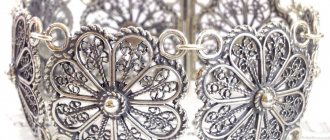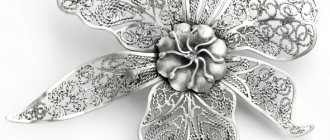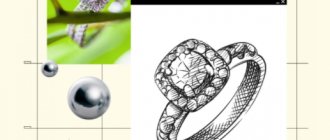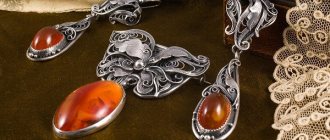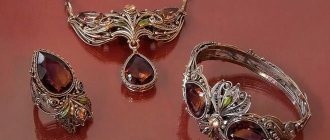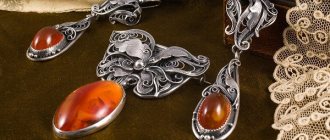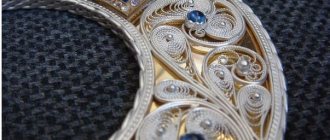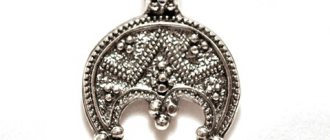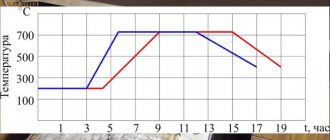Filigree (in Russian - scan) is a pattern of thin wire soldered onto metal. Almost everyone has encountered filigree; many families probably have preserved objects made using this jewelry art.
The word “filigree” itself seems to hint at the production technology. Translated from Latin, “filum” means thread, and “granum” means grain. The Russian word “skan” comes from the Old Russian “skat”, which means “to twist, twist”. This technique is mainly used on silver items, such as spoons, coasters, and women's earrings, but the material can also be other precious metals such as gold and platinum.
The reason for the fascination with silver and gold is the softness of these metals; very thin wires can be twisted from them. The basis of filigree is silver or gold wire, which can be either smooth or twisted into a kind of rope.
A Brief History of Filigree
If we turn to the history of its origin, it will take us to ancient Egypt, Crete and Greece. Already in the 4th-6th centuries BC. filigree was one of the basic jewelry techniques for making openwork jewelry.
In the 17th century, the demand for filigree jewelry increased. In the 18th century, filigree was combined with stones, crystal, and mother-of-pearl. Using filigree, vases, salt shakers, and boxes are made. Since the 19th century, filigree has become a manufactured commodity. The art is improving, relief openwork filigree is flourishing, and a stained glass variety with transparent enamel appears. In 1937, the work of jewelers from the village of Krasnoe-on-Volga was shown at the world exhibition in Paris, where it created a real sensation, and in 1939 the success was repeated in New York. Filigree began to be worked in the village of Kazachkovo, Nizhny Novgorod region.
Filigree – tenderness and airiness of jewelry
Almost everyone is familiar with the expression “filigree work,” but few have any idea of its origin. Filigree is a type of jewelry craftsmanship, the finest interweaving of silver threads from which real masterpieces are created.
The technique is well known to the masters of yesteryear, who created products that have survived to this day.
Filigree and filigree
The only differences are in the origin of the words; they denote one type of jewelry art. The name “scan” comes from the Old Russian word “skat”, meaning “to twist”, “to twist”, which accurately reflects the essence of the work.
The word “filigree” comes from Latin words that are translated as “grain”, “thread”.
Who owns the filigree technique: historical background
It is believed that the first masters who mastered this interesting technique appeared in Ancient Egypt and ancient Greece. The oldest items discovered during excavations of ancient cities date back to the 6th century BC.
The rapid growth in popularity of filigree products was noted in the 18th century.
European craftsmen created unique jewelry for wealthy citizens and nobles. The 19th century is rightfully considered the heyday of filigree crafts. At this time, jewelry began to be mass produced and was available to almost all classes.
Russian filigree originates in ancient centuries. Filigree in Ancient Rus' was primarily a ritual item, which then migrated to the princesses’ boxes.
The famous Krasnoselskaya filigree created a worldwide sensation at the Paris Exhibition in 1937. Success was repeated 2 years later in New York.
Types of jewelry filigree
Depending on the technique used to create the work of art, there are several types of filigree.
Brazed filigree
This type of filigree was popular in medieval Europe. The method involves soldering a silver thread onto a previously prepared metal plate.
If the plate remains in the finished product, then this type is called background or “blank”. In some cases, the background is sawed out, resulting in a cut-out filigree.
Openwork filigree
The peculiarity of openwork filigree is the absence of a background. A pattern is assembled from silver threads soldered together. The grain is soldered onto the wire. If it is not in the product, then it is called flat lace.
Two- and three-dimensional volumetric filigree patterns are called sculptural-relief filigree.
Volumetric filigree
Separately, we should highlight products made using the volumetric filigree technique. Often, such filigree takes the form of household items, dishes, figurines of birds and animals.
Due to the increased complexity of the product, individual filigree elements are first created, which are then combined into one whole.
How filigree jewelry is made
Filigree combines several basic elements that make up the finished pattern - rope, lace, herringbone, wicker, track. Sometimes grains - small metal balls - are added to jewelry.
They are soldered onto the surface of the main pattern, repeating it. Such decorations look unusual and elegant.
Silver is often used to make filigree items. You can find jewelry made of gold, brass, cupronickel, and copper.
Jewelry of any complexity is created using the filigree technique. The final cost depends not only on the material used, but also on the complexity of the technology.
Silver filigree: manufacturing technology
In ancient times, a jewelry master was engaged in the manufacture of filigree from the development of a sketch to the final polishing of the product.
Today, large productions divide the work into stages, so a whole team of specialists is involved in the manufacture of one piece of jewelry. Private jewelers still make their own filigree. Schemes of patterns and motifs are passed on from master to student.
Production begins with the production of thin metal wire. To do this, a solid silver bar is heated, softened, and then drawn out. Rolls out to the desired length and thickness.
The rock patterns are assembled from individual elements, so the next stage is their manufacture. A thin wire is bent using special tweezers - a forceps.
The finished parts are applied to paper with a pre-drawn drawing of the product. If all the elements are assembled, then the master starts soldering. The openwork elements are securely fastened together, forming a single whole.
A well-made product is durable, despite its external tenderness and airiness.
The final stage of production is rhodium plating of silver jewelry and silver plating of metal jewelry (pure 999.99 silver is used for this). In some cases, artificial aging is performed by oxidizing the metal.
The history of the heyday of filigree
The growing popularity of unusual technology begins in the 17th century. Masterpieces are created that compete with crystal vases, figurines, and household items.
Production technology is becoming more complex: techniques are used to combine metal filigree patterns with enamel, crystal, mother-of-pearl, and semi-precious stones.
The decline in the popularity of jewelry began during the First World War.
Kazakovskaya filigree – modern production
To this day, the Kazakovsky Art Products Enterprise has been developing and producing unique works of art. Kazakovsky filigree is distinguished by its openwork and airiness.
Design artists spend a lot of time working on every detail so that the product looks harmonious using classical technology.
Filigree from "Kubachi"
The Kubachi jewelry factory launched its production in the village of the same name. The products are known throughout the country. The uniqueness of the jewelry lies in the combination of classical filigree techniques with embossing, engraving, and Dagestan blackening.
The result is completely non-trivial things.
Products with filigree elements versus true filigree
Certain elements of scanned technology are widely used to make jewelry. For example, grains can often be found in rings and earrings. Combining techniques makes it possible to get an interesting result.
Classic filigree is too pretentious for everyday wear. The buyer will prefer a simpler product, but with filigree elements.
Grain and filigree of Ancient Rus'
The technique of making jewelry began to be used on the territory of the Russian state in the 10th century. This period is characterized by an abundance of grains of different sizes and a small variety of filigree elements. Then the production technology developed to the production of soldered filigree; from the 12th century, craftsmen mastered the technique of openwork, relief filigree.
During the time of Tsarist Russia, filigree items were made in different sizes - from large-scale canvases to small brooches and earrings. The most famous masters were Ambrose and Ivan Fomin, whose products have survived to this day.
False (cast) filigree and grain
These techniques appeared to reduce the cost of the manufacturing process and speed it up. False (cast) filigree and grain are products cast in pre-made slate and limestone molds. Such decorations are similar to the original filigree decorations, but differed from them in simpler, smooth designs without relief.
How to Wear Filigree Jewelry
Pretentious filigree items are not jewelry for every day. They often complement pre-created looks and are used as eye-catching accessories.
Wearing such products requires a thoughtful combination with the material, hair color, and unity with the style of clothing. Light silver jewelry emphasizes dark skin tones and bright fabrics.
Dark, blackened items are revealed in contrast with light-colored clothing.
Filigree technique:
Types of filigree
If we consider the types of filigree, then it can be soldered, openwork and volumetric.
- Soldered filigree . In it, wire and grain are soldered directly onto sheet metal. If you leave the background, you get background or so-called “deaf” filigree.
- Perforated (cut) filigree . Created by removing the background.
- Relief filigree . In this case, the pattern is soldered onto the embossed relief.
- Openwork filigree . The metal base is completely absent, the wire pattern is soldered, and the grain is attached to the metal lace. The lace itself can be flat, then it is a flat openwork filigree, but if the soldering occurs in two dimensions, then the result is a sculptural openwork type. Openwork, without a background, is usually called Russian filigree.
- Volumetric filigree consists of parts mounted into a single composition. This is how objects of jewelry are created, such as all kinds of cups, trays, caskets and vases.
Filigree in jewelry. Precious lace technology | SOKOLOV Magazine
Scanning technology, drawing layout
At a time when there was no large-scale jewelry production, when jewelry was considered a luxury, filigree arose in Rus'. The unique technique of artistic metal processing has been passed down from generation to generation, preserving the ancient secrets of weaving precious lace.
Filigree and filigree
Often people who are far from jewelry production have a question: what is the difference between filigree and filigree?
The term “filigree” has Latin roots and comes from two words filum - thread and granum - grain.
In our country, this decorative method of metal processing has acquired not only a unique Russian flavor, but also another name - filigree (from the Old Russian “skati” - to twist, twist).
In jewelry, both concepts mean a special technique for making products by soldering thin wire from precious metals into a pattern. Often filigree jewelry is complemented with enamel, stones and grains - small gold or silver balls.
From the history of filigree
In Rus', filigree technology has a long history. Back in the 9th-10th centuries, grain began to be used to decorate jewelry.
Later, in the 12th-16th centuries, in addition to brazed filigree, openwork filigree began to be used, which was supplemented with stones, enamel and even wood.
The most ancient filigree creations of this period - "Monomakh's Cap" and "Ryazan Barms" - are now kept in the Armory Chamber.
Russian filigree flourished in the 18th-19th centuries, when it acquired the status of jewelry.
At this time, not only small objects (vases, boxes, cigarette cases), but also voluminous decorative panels were created using the filigree technique.
The production of filigree items is acquiring an industrial scale: jewelry factories produce dishes, church utensils and various accessories. And yet, each such decoration was created by hand.
In the 20th century, Art Nouveau style makes new demands on jewelry fashion. Other methods of decorating jewelry are being developed, and some manufacturing processes are being mechanized. However, with all the diversity of jewelry production technologies, the methods of making scanned items remain traditional.
Types of filigree
Depending on the chosen technique, there are several types of filigree.
When using soldered filigree, the resulting pattern is applied to a metal base.
Openwork filigree is a method of making filigree in which decorative elements are soldered together without a background, forming metal lace.
Three-dimensional filigree is used to create objects such as vases, goblets, boxes, animal figures, etc. These products are made from separate parts, which are then combined into a single composition.
How filigree lace is woven
To create scanned masterpieces that look like frosty lace, you don't need a lot of tools or high-tech equipment. Much more important here is the skill and talent of a specialist who performs truly jewelry work.
Wire twisted into elements of a scanned product
Wire Twisting
Pre-flared wire is sorted by thickness, twisted or left smooth, depending on the design idea.
Layout of elements according to the drawing
The filigree is collected exclusively by hand. Interestingly, incredibly delicate filigree lace is made up of just a few traditional elements, the most common of which are a ring, a gear, a curl, a clove, a burr and a grass.
The most common filigree elements
The pattern drawn on paper is made of metal wire and glued to the sketch. The elements must be absolutely identical, which is why a necessary condition for the work is to create a full-size sketch of the product.
Soldering the scanned pattern
Next, the glued parts are soldered together, forming larger elements. Under the influence of the flame, the paper burns, but the metal pattern remains. This is an equally painstaking process, since if the temperature is too long or too strong, not only the paper will be destroyed, but also the thin scanned lace.
To give the metal a special shine, the parts are dipped into a special chemical solution, polished and only then joined together.
Scan in modern times
Nowadays, scanned items are considered a masterpiece of jewelry art and an attribute of high fashion.
At the beginning of 2014, the fashion world was shocked by the winter collection of accessories from Dolce&Gabbana. One of the designer finds was bags and shoes decorated with gold filigree. In the “filigree” accessories studded with stones, lace sounded in a new way, while preserving the richness and luxury of ancient jewelry techniques. This collection became a landmark event, raising filigree to the rank of high fashion.
Collection from Dolce&Gabbana with filigree motifs
The perfection of natural forms inspired the craftsmen of the SOKOLOV company to create silver filigree falcons, which became symbols of the brand.
Incredibly beautiful patterns seem miraculous and amaze with their sophistication and weightlessness.
The embodiment of the beauty and graceful lightness of the freedom-loving bird became possible thanks to a combination of ancient filigree-making secrets and the unsurpassed skill of jewelers.
Falcon made of filigree silver
Falcon made of filigree silver
Elements of a filigree product
Scan in close-up
Scan details
Filigree techniques in the world
Beautiful lace is by no means a Russian folk craft. Filigree products are made by artisans all over the globe. Let's turn to world practices and their features. There are several main modern schools of filigree.
In Armenia they are used to making thin and flat shapes. In Dagestan they love abundant grains and hemispheres. In the glorious ancient Russian city of Kostroma, complex volumetric shapes of products prevail. European jewelers from France and England are also no strangers to filigree craftsmanship. Moreover, you can find openwork patterns in Latin American jewelry, for example, from Ecuador. In South America, the scanner fishery is generally quite developed.
Historical background of the emergence of technology
The technology called filigree, used to create a variety of creative objects, belongs to ancient crafts that have been known in our country since the 12-13th century. Initially, the technique was used in metal processing to obtain the finest patterns and visually lighten an object or decoration. The elements of the pattern are varied - weaving, path, herringbone. Fastening technique - soldering. Nowadays, both brazed and lumpy filigree are often used by jewelers as a style to create jewelry, such as openwork rings with and without stones. Russian filigree was published and called by another word - filigree. Depending on what material filigree is made from, this technique can be used to create a variety of products - from jewelry and paintings, to toys for children and letters on panels. See pictures with examples of such products in the gallery below.
Main metals used in the work process:
- Platinum;
- Silver;
- Brass;
- Cupronickel;
- Copper.
Gold is also used. The basic elements were later transferred to other materials - today, crafts and decorations with filigree are made from paper, fabric or jute.
The creation process requires special patience and accuracy from a person; it should also be taken into account that creativity requires a significant investment of time.
Technology for making silver filigree
Previously, a master of scanned art worked at all stages of the process of creating a product. In modern production, division of labor is used, but the technology itself has remained unchanged. What does she look like?
To make lace (filigree), you need:
- bend the details of the design using tweezers;
- lay them out on paper with a pattern;
- adjust and glue them in place;
- in the case of background scans, simply fasten them together;
- the final stage is silver plating of the product with anode silver and composition using the oxidation method.
Interesting!
The density of the filigree plays a paramount role. If the set is loose, the lace “frays”, which leads to alteration.
How to make earrings using filigree
In order to create an unusual, exclusive and simply stylish decoration with your own hands, which uses filigree technology, you will need:
- Earrings (metal base) – 1 pair;
- Ear wires – 2 pcs (it is better to use those included with the base);
- Baked clay (polymer) – any color and shade, several options, can be used with glitter;
- Thin needle;
- Stationery knife;
- Surface for working with clay (plastic board or tile).
The main requirements are a clean work space, a good mood, and patience. Main stages of work:
- Mix the colors of polymer clay to achieve the intended shade;
- Take the base for the earrings and the resulting clay, divide it into two parts;
- Form a shape that fits the recess that is at the base of the earrings;
- Make thin threads from contrasting colored clay blanks (cut them with a stationery knife into the required lengths);
- Using a needle, place them on the clay located inside the blanks;
- Form the necessary (pre-thought-out) picture on each workpiece;
- In an oven preheated to 110 degrees, you will need to bake the future earrings. To do this, they should be placed on a glass base or foil. Bake for 15 minutes;
- The resulting clay blank will need to be glued to the base. For this purpose, it is necessary to use a special glue - gel for polymer clay;
- Press the parts together and wait 3-5 minutes.
Earrings created using filigree are ready to use.
Kazakovskaya filigree
Currently, the Kazakovsky Art Products Enterprise is a global brand specializing exclusively in the production of filigree products from a silver-plated alloy. Kazakov jewelry is distinguished by the harmony of all parts, the beauty and precision of the smallest elements. Therefore, they became the “elite” of silver jewelry for women.
In addition to openwork earrings, rings and necklaces, the assortment is quite diverse. Everyone will find their products there: silverware - a housewife, openwork keychains - hipsters, a smoker with taste - smoking accessories.
What you need to work with jute
The necessary materials and tools can be purchased at any hardware store.
The table shows a list of accessories for working with filigree:
| Making products using the jute filigree method | |
| Materials | Tools |
|
|
Kubachi filigree
The famous filigree technique of Dagestan masters from the village of Kubachi has long been known to connoisseurs and just ordinary people. Possessing knowledge and skills passed down from generation to generation from father to son, Kubachi artisans create miracles with the help of blackening, chasing and engraving.
It is interesting to note that individual families specialize in different products. One family skillfully produces women's jewelry, another - silver tableware, a third - daggers with silver inlay, and so on. Each Kubachi master has his own special signature style of manufacturing.
The Kubachi silverware simply amazes with its sophistication and unique charm, and, it is worth noting, at a price quite affordable for a good gift.
What else do artisans from Kubachi make:
- silver bracelets for women and men;
- Bismarck weave silver chains;
- pendants, pendants and necklaces;
- souvenir silver horseshoes;
- coasters, cups, mugs;
- wine glasses, glasses, shot glasses and shot glasses;
- unique silver earrings;
- men's belts with silver buckle.
This is not yet a complete list of what the masters of the Dagestan village are famous for.
Kubachi silver is a true handmade masterpiece, accessible to ordinary people.
Jute craft ideas
Jute filigree (drawings for products and master classes are presented later in the article) is the basis for creating all kinds of decorative and household items.
Items made using the filigree method can serve as original gifts for holidays and celebrations. Painted with gold or silver, the works will look like openwork wicker metal products.
Examples of products that can be made using the jute weaving technique:
- openwork napkins;
- coasters for hot dishes and mugs;
- napkin holders;
- caskets;
- decorative baskets;
- frames for photographs and mirrors;
- lampshades;
- decorative elements in the form of butterflies, feathers, dragonflies, flowers.
How to wear filigree jewelry best
Those who are just looking at filigree jewelry should consider making such jewelry look as impressive as possible. Lace requires a contrasting background, a unified style with clothing. For example, light filigree looks great on dark tanned skin and brunettes. Fabric with blackening, on the contrary, looks impressive on blondes and white-skinned women; accordingly, clothes should also be of a light shade. If you follow the law of contrast, you will definitely become the object of admiring glances!
Useful tips for choosing threads
For creativity, you can choose any thread. This can be ordinary yarn and cords made from natural materials of different thicknesses.
To make colored products, craftsmen suggest pre-dying the same jute cord, then all the work will turn out in the same style. The threads are dyed by dipping into acrylic paint, or lightened to the desired color with a solution of household chlorine-based bleach.
Jute rope has some disadvantages that are inherent in natural materials: it absorbs moisture and is susceptible to rotting. Therefore, analogues of jute are used to make presentable products, such as manila cord and linen twine. Manila rope is stronger than its analogues and does not absorb water. The difference between linen cord is that it is soft and pliable.
